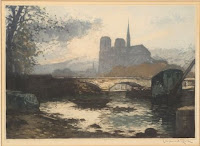(1893-1980)
Czech painter, printmaker, professor at Prag Art School.
Meeting all sorts of interesting artists along my stay in Paris and visits to Quai de la Tournelle it's now time for some serious and printmaking business. Woodcuts by an artist who was trained by important and influential artist and professor Max Svabinsky (1873-1962) in Prag and later also studied philosophy at the Sorbonne in Paris.
Karel Tondl, fellow countryman and contemporary of the great Frantisek Tavik Simon (1899-1942) who lived and owned a studio in Paris, both painters and printmakers, in later life, like his teacher Svabinsky, was appointed professor in Prag. He created in 1930 this port folio with some of the most exquisite woodcut prints: A day by the river Seine, 6 views of Paris.
 I perticularly like the prints were Tondl stages people in these compositions. Reading, walking (the dog), hanging over a railing or fishing. Charles Augustin Lhermitte, (1881-1945) the contemporary photographer does that too as I showed in the before posting.
I perticularly like the prints were Tondl stages people in these compositions. Reading, walking (the dog), hanging over a railing or fishing. Charles Augustin Lhermitte, (1881-1945) the contemporary photographer does that too as I showed in the before posting.
In these last two (and the first two) Tondl is showing the characteristic bateaux lavoir, the city's many floating washing (and bathing) facilities which came into fashion in the mid 18th century were in use until around 1940. This posting will be followed by an article about this typical river bound industry, many of theses boats were immortalized by Charles Lhermitte (son of painter Leon Lhermitte (1844-1925) who was greatly admired by Vincent van Gogh) and various other fine artists.
Tondl exhibited world wide (see the print of New-York city below) and I can't resist showing a small selection here of his great artistic skills.
Besides his woodcut printmaking Karel Tondl is best known for his expressionist paintings of bathing women. In the style and colors of Matisse' bathers, lake side dancers and nudes.
See also my 3 other (I can now say very well read and popular) postings on the theme of bathing women and printmaking (here).
Karel Tondl, fellow countryman and contemporary of the great Frantisek Tavik Simon (1899-1942) who lived and owned a studio in Paris, both painters and printmakers, in later life, like his teacher Svabinsky, was appointed professor in Prag. He created in 1930 this port folio with some of the most exquisite woodcut prints: A day by the river Seine, 6 views of Paris.
"Towards Pont Neuf", photograph found in an old book on Paris, notice the bateaux lavoir and see also the postcard photo below.
 I perticularly like the prints were Tondl stages people in these compositions. Reading, walking (the dog), hanging over a railing or fishing. Charles Augustin Lhermitte, (1881-1945) the contemporary photographer does that too as I showed in the before posting.
I perticularly like the prints were Tondl stages people in these compositions. Reading, walking (the dog), hanging over a railing or fishing. Charles Augustin Lhermitte, (1881-1945) the contemporary photographer does that too as I showed in the before posting. In these last two (and the first two) Tondl is showing the characteristic bateaux lavoir, the city's many floating washing (and bathing) facilities which came into fashion in the mid 18th century were in use until around 1940. This posting will be followed by an article about this typical river bound industry, many of theses boats were immortalized by Charles Lhermitte (son of painter Leon Lhermitte (1844-1925) who was greatly admired by Vincent van Gogh) and various other fine artists.
Tondl exhibited world wide (see the print of New-York city below) and I can't resist showing a small selection here of his great artistic skills.
Besides his woodcut printmaking Karel Tondl is best known for his expressionist paintings of bathing women. In the style and colors of Matisse' bathers, lake side dancers and nudes.
See also my 3 other (I can now say very well read and popular) postings on the theme of bathing women and printmaking (here).

And last but not least included in this posting is a nice example of Tondl's Prag teacher Max Svabinsky who will have his own private posting in the Linosaurus soon. In this print there's also the hinting at Matisse. And do I detect a touch of Anders Zorn and maybe a dash of Paul Degas in the choice of moment ?
Tondl's Paris woodcut print pictures borrowed freely from: http://www.tfsimon.com/bubenec-cemetery-artists.htm. A highly intereting website I strongly recommend visiting.

























+1912+Quay+et+Pont+de+la+Tournell.jpg)
+1912+pont+marie+grue+vapeur.jpg)


,+Giton+Ren%C3%A9+(1908-2003)+1935.jpg)

.jpg)









.JPG)


















,+1911+.-+EUGE%CC%80NE+ATGET.jpeg)


